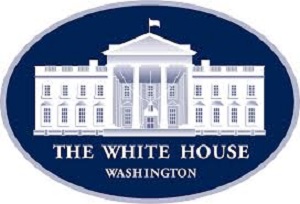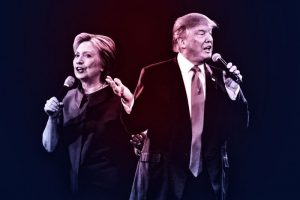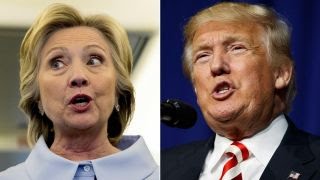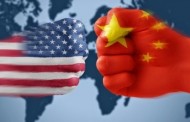So Sánh Sơ Lược Cuộc Bầu Cử Tổng Thống Hoa Kỳ Năm 2016 và 2000
Cuộc bầu cử năm nay giống y như bầu cừ năm 2000 giữa Gore và Bush, hai bên tranh dành quyết liệt tại Florida; hiện qua thăm dò, hai UCV Hillary Clinton & Donald Trump cũng ngang nhau tại Florida.
Các bang nghiêng ngả chưa bầu cho ai (toss up/swing states) gồm 15 tiểu bang: Florida (29 phiếu cử tri đoàn) , Ohio (18), Pennsylvania (20)…v.v, tổng cộng 185 phiếu.
Nay Clinton qua thăm dò Real Clear Politics được 188 phiếu, Trump 165, hơn nhau 22 phiếu. Bao giờ cũng vậy, UCV Dân chủ luôn hơn UCV Cộng hòa trong giai đoạn đầu cuộc tranh cử vì họ tuy có ít tiểu bang nghiêng hay thuộc về Dân Chủ, nhưng toàn là Tiểu bang đông dân, với vựa phiếu lớn như Cali (55), New York (29), Illinois (20) … còn Cộng hòa tuy có nhiều Tiểu bang nghiêng hay thuộc về họ nhưng toàn là những bang thưa dân, cho nên Cộng hoà chỉ “lượm bạc cắc”, miễn sao cho “đầy túi” bầu cử.
Do đó, trước khi giao đấu thường là DC hơn CH vài chục phiếu. Hơn một tháng trước Clinton hơn Trump khoảng 60, 50 phiếu nay tụt xuống còn 22 phiếu. Nay các bang Swing states nghiêng về Trump theo thăm dò là Ohio (18), NC (15), Nevada (6) Colorado (9) Iowa (6) Arizona (11) Georgia (16). Tổng cộng Trump được 81 phiếu, trong khi các bang Swing states nghiêng về Clinton gồm Pennsylvania (20), Minesota (10), Wisconsin (10). Michigan (16) VA (13) New Hampshire (4) Maine (2) tổng cộng 75.
Tổng cộng toàn bộ Clinton 188+ 75 = 263
Tộng cộng toàn bộ Trump 165+81= 246
Như vậy Trump còn thiếu 24 phiếu
Clinton còn thiếu 7 phiếu
Tiểu bang quyết định vẫn là Florida như năm 2000. Florida có 29 phiếu, nay tại Florida hai bên UCV ngang nhau.
• Nếu Trump vớ được FL thì sẽ được 246+29= 275 (đủ 270 phiếu)
• Còn nếu Clinton vớ được FL thì sẽ được 263+29= 292 phiếu.
Tuy vậy từ nay tới bầu cử còn thay đổi thiên hình vạn trạng, nay mỗi ngày Clinton mất một ít điểm (độ 1, 2 điểm), các nước trên thế giới cũng theo dõi bầu cử Mỹ, họ mong Clinton thắng và sợ TRUMP thắng vì sẽ thay đổi chính sách.
Trọng Đạt
Wall Street wakes up to the possibility of a Trump win
September 26, 2016
For more than a year, Wall Street pros had been treating Donald Trump ‘s candidacy as a sideshow not to be taken seriously.
Now, on the eve of Monday night’s first debate between Trump and Hillary Clinton and with polls showing the race a virtual dead heat, it’s not a joke anymore.
Instead, top investment minds on the Street are providing clients advice on how to position ahead of the election. Those scenarios now are taking into serious consideration what would happen should Trump prevail .
And prevail he might: The Real Clear Politics polling average gives Clinton just a 1.5-point lead in a four-way race. Nate Silver’s FiveThirtyEight site has Trump holding a 48.5 percent chance in the polls-only forecast (51.5 percent for Clinton), the highest the GOP candidate has been since July 31 and up dramatically from a low of 10.8 percent on Aug. 14. However, the site’s “Now-cast” projection of who would win the race if it was held today assigns a 54.9 percent to a Trump victory.
Previous surveys have indicated that at least 70 percent of Wall Street strategists expect a Clinton win.
The forecasts for a Trump win, though, aren’t as extreme as might be expected.
In fact, several strategists believe a Trump presidency might not bring about radical change, despite the New York businessman’s pledge to revamp long-established trade deals, slash taxes for businesses and individuals and demolish the government-run health-care program.
That’s primarily because even in the scenario where the Republican prevails, the greater likelihood is that he’ll have to deal with a divided Congress where it’s difficult to push through major initiatives. Morgan Stanley analysts call this scenario “policy incrementalism” and believe that it’s the most likely outcome regardless of who wins the presidency.
However, should Trump win and hold majorities in both halls of Congress, the potential for greater change increases.
“While Clinton still appears to enjoy greater support for the presidency than Trump, the market impacts of a Trump presidency cannot be dismissed as a tail risk,” fixed income strategists at Morgan Stanley said in a report for clients.
The report broadly notes that investors need to prepare better for market volatility as the election nears, a sentiment common on the Street.
“We believe the current below-average level of uncertainty is unlikely to persist,” David Kostin, chief U.S. equity strategist at Goldman Sachs, said in his weekly report for clients that compared Monday’s debate hype to 2015’s boxing matchup between Floyd Mayweather and Manny Pacquiao.
Kostin also believes there will be a common thread no matter whether Clinton or Trump prevail — fiscal stimulus, continued pressure on health care (the second-worst-performing S&P 500 (INDEX: .SPX) sector this year) and volatility.
“Regardless of victor, the most likely policy outcome of the election is increased fiscal spending,” Kostin wrote. “We recommend clients vote with their wallets and focus on the likely beneficiaries.”
From a policy standpoint, one area where the Trump candidacy stands out is his strident approach to trade deals. He opposes the Trans-Pacific Partnership , wants to renegotiate the North American Free Trade Agreement and has threatened to label China a currency manipulator.
However, the net result of this approach may not be a trade war but rather saber-rattling to little effect, according to one analysis.
“It is impossible to be sure what Donald Trump would actually do if he became U.S. president, but our best guess is that he would back away from his most radical proposals on trade policy. And even if he carried out his threats, the consequences would probably be less damaging than many fear,” Andrew Kenningham, senior global economist at Capital Economics, said in a note.
“Overall, it is not clear that aggressive trade policies by the U.S. would unleash a wave of protectionist measures comparable to that which occurred after the infamous Smoot-Hawley tariff in 1930,” he added.
Kenningham compared the Trump plans to Richard Nixon’s 10 percent import surcharge in 1971, and the battles Ronald Reagan waged in the 1980s to get Japan to institute voluntary export limits. Both measures proved effective.
“In a similar vein, threats from the U.S. could, for example, persuade China to scale back subsidies for its steel industry,” Kenningham said.
Ultimately, then, the Clinton-Trump showdown could make for great theater but prompt more nuanced responses from investors.
Wells Fargo is encouraging its clients to sit tight and not make any impulsive decisions based on which way the political winds are blowing. The firm’s four potential election scenarios currently equate to a 50-50 chance for either candidate.
“We believe that the worst risks to the financial markets … have the lowest probabilities of occurring and advise investors not to allow the candidates’ broad unpopularity to drive fear of worse financial market impacts than are likely,” the firm said in a report. “In our view, investors should avoid large portfolio changes based on election fears or speculation.”
From Yahoo Finance
September 26, 2016
















































